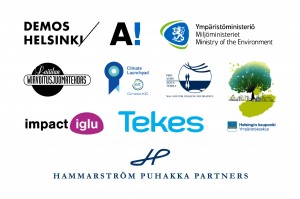The world’s largest climate innovation contest ClimateLaunchpad culminates at the national level in Microsoft Flux (Korkeavuorenkatu 35, Helsinki) 15.6. at 16:30, when 9 Finnish finalists will pitch their concepts. Sign up for the event here to hear ideas ranging from renewable-energy based solutions to clothes rental services. ClimateLaunchpad aims to…
The world’s largest climate innovation contest ClimateLaunchpad culminates at the national level in Microsoft Flux (Korkeavuorenkatu 35, Helsinki) 15.6. at 16:30, when 9 Finnish finalists will pitch their concepts. Sign up for the event here to hear ideas ranging from renewable-energy based solutions to clothes rental services.
ClimateLaunchpad aims to identify and push forward the most promising ideas and teams to tackle climate change. Out of the 40 Finnish teams that applied, 9 have been helped to make their solutions viable and attractive investors during the spring. After the Helsinki final, the top three teams will be sent to the European finals in Tallinn in September.
– We’ve been blown away by the variation and the passion of the teams. All of these solutions are important ones, as wicked problems like climate change need to be addressed from multiple angles at the same time, says Satu Lähteenoja, Head of Resource Smart Economy at Demos Helsinki.
The ideas are worth having a look at. Here are 9 new Finnish solutions to tackling climate change and pitching on Flux’s stage:
-
Give new life to plastic and concrete
The idea behind Super Synthetic Stones is to combine two of the world’s worst materials, plastic and concrete, to create a new material that could reduce cement and natural aggregate demand and also give new value and life to unrecycled waste plastics. Since plastic, for example, improves the insulating characteristics of concrete and adds to its aesthetic value, the material can be used widely in architecture and furniture.
-
Count people – save energy
Padurn develops digital people counting solutions to provide the data needed for implementing the principles of resource efficiency as well as sharing and circular economy inside buildings. Data from various existing systems (like access control and time clocks) and from new solutions (e.g. iBeacons) will be integrated to optimise the building control system schedules. Besides reduced rent and energy costs, the benefits of the solution include decreased environmental impact.
-
Rent your clothes
Rent-in-Shop offers a platform through which consumers can lease high-quality garments directly from their favourite brands. By paying a monthly fee customers can enjoy using a beautiful garment without the burden of storing, re-selling or recycling – thus bringing the wardrobe to the post-ownership era of fashion.
-
Cook with energy from waste
ReKindle’s subscription based service supplies anaerobic biogas to medium-sized and large restaurants in Nepal by reusing their own organic wastes. ReKindle’s aim is to provide not only an affordable and accessible, but also reliable and renewable option for restaurants’ fuel self-sufficiency.
-
Eat sustainably – not only in your home
For restaurants and event organizers the brand of sustainable food service problem is a competitive advantage. As a member of the Sustainable Meal network, food service providers get consultancy on designing environmentally friendly meals, as well as extensive and exclusive marketing channels provided by the network. By paying an annual fee, the network members benefit by new customer acquisition and strengthening their image as a responsible food service provider.
-
Use ecological energy during power cuts
Fineria Energy was established to build and supply cleantech-driven hybrid power solutions to alleviate the power deficiencies in developing countries. These hybrid generators will maximize the use of multiple renewable energy sources, backed-up by highly efficient fossil-based source to provide reliable and cost efficient power to areas in need.
-
Prevent water emissions
Fire & Water has created a predictive SaaS solution for wastewater treatment. The solution aims at optimizing the wastewater treatment process in order to minimize both the input of chemicals and the output of nutrients to the environment. The solution brings also results that will activate the mandatory corporate social responsibility and also save money.
-
Take a photo of pollution
VisionAir is developing a technology to detect different levels of pollutants in the air based on images. The algorithm is aimed to work with any camera, thus making it possible to build air quality sensor networks out of existing cameras spread around the city – such as traffic, weather or security cameras. The solution offers authorities a cost effective way to expand the coverage of current air quality monitoring systems while avoiding the high investments otherwise involved.
-
Put Carbon back to soil
The mission of Soil&Co is to change conventional farming to CO negative while helping farmers to be more profitable. Conventional farming is, at the moment, based on short-term gains and big negative climate impact, because it destroys the soil’s ability to sequester CO and other greenhouse gases.
Which ones would you try?
The jury of Finnish program features top experts from cleantech pros to startup folk, including investor and founder of Cleantech Invest Tarja Teppo, founder of Hupparihörhö Sami Kuusela, director and head of Regus Kora operations Jaana Pylvänen, expert of Environment Centre of Helsinki Mira Jarkko and Demos Helsinki’s CEO Tuuli Kaskinen. They picked the best teams for the program from over 40.
ClimateLaunchpad Finland is powered by Impact Iglu, Demos Helsinki’s Peloton Club, Aalto University, ClimateKic, Maj and Tor Nessling Foundation, Tekes and Ministry of Environment. Laitilan Wirvoitusjuomatehdas quenches guest’s thirst at Pitch Show.
Book your free tickets here!
More information: johannes.mikkonen@demoshelsinki.fi, +358405694948

